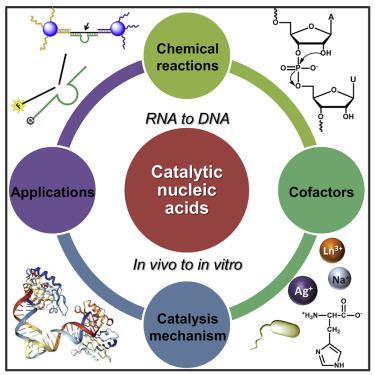iScience ( IF 4.6 ) Pub Date : 2020-01-02 , DOI: 10.1016/j.isci.2019.100815 Lingzi Ma 1 , Juewen Liu 1

|
Since the initial discovery of ribozymes in the early 1980s, catalytic nucleic acids have been used in different areas. Compared with protein enzymes, catalytic nucleic acids are programmable in structure, easy to modify, and more stable especially for DNA. We take a historic view to summarize a few main interdisciplinary areas of research on nucleic acid enzymes that may have broader impacts. Early efforts on ribozymes in the 1980s have broken the notion that all enzymes are proteins, supplying new evidence for the RNA world hypothesis. In 1994, the first catalytic DNA (DNAzyme) was reported. Since 2000, the biosensor applications of DNAzymes have emerged and DNAzymes are particularly useful for detecting metal ions, a challenging task for enzymes and antibodies. Combined with nanotechnology, DNAzymes are key building elements for switches allowing dynamic control of materials assembly. The search for new DNAzymes and ribozymes is facilitated by developments in DNA sequencing and computational algorithms, further broadening our fundamental understanding of their biochemistry.
中文翻译:

催化核酸:生物化学、化学生物学、生物传感器和纳米技术。
自 20 世纪 80 年代初首次发现核酶以来,催化核酸已被应用于不同领域。与蛋白酶相比,催化核酸结构可编程,易于修饰,尤其对于DNA而言更稳定。我们以历史的视角总结了核酸酶可能产生更广泛影响的几个主要跨学科研究领域。 20世纪80年代对核酶的早期研究打破了所有酶都是蛋白质的观念,为RNA世界假说提供了新的证据。 1994年,第一个催化DNA(DNAzyme)被报道。自 2000 年以来,DNAzymes 的生物传感器应用已经出现,DNAzymes 特别适用于检测金属离子,这对酶和抗体来说是一项具有挑战性的任务。与纳米技术相结合,DNAzyme 是开关的关键构建元件,可动态控制材料组装。 DNA测序和计算算法的发展促进了对新DNA酶和核酶的探索,进一步拓宽了我们对其生物化学的基本理解。











































 京公网安备 11010802027423号
京公网安备 11010802027423号